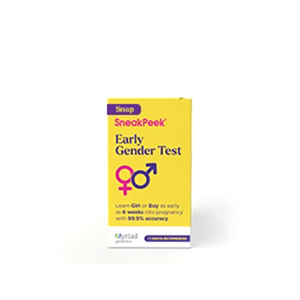Published on February 4th, 2022 and Updated on February 29th, 2024
Check out SneakPeek Gender Test to find out your baby’s gender as early as 6 weeks at over 99% accuracy1!
For women who are trying to conceive, ovulation can occupy a ton of headspace. We talk about it at length with our girlfriends. We mark it on our calendars and log it in our apps. We text our partners excitedly when the signs point to “yes,” “hurry,” and “now.”
It’s no wonder why: Ovulation, the phase in the menstrual cycle during which the ovary releases a mature egg, marks our fertile window. If we’re eager to welcome a little one into our family, discovering that we’re ovulating can make us feel all the feels. We feel hopeful and excited by the possibilities enshrined in our bodies. We might feel a little hot under the collar, thanks to our elevated body temps and libidos. And sometimes, we feel a bit of sharp pain, in the form of ovulation cramps.
In the guide below, we’ll take a close look at ovulation cramps—what’s causing them, what they feel like, and how long they last—so that you can accurately track your menstrual period cycle and make the most of your baby-making.
Ovulation 101
To figure out what’s going on during ovulation—and why do you sometimes experience painful ovulation—let’s set the scene.
So first thing first, ever wondered how many days after your period do you ovulate? You are in the right place. Ovulation Is day 14 of a regularly scheduled (28-day average) menstrual cycle. Any moment now, your ovary is due to drop a mature egg, thanks to a rush of luteinizing hormone (LH) that hit 28 to 36 hours earlier (and you haven’t been this excited for a drop since Adele teased her divorce album).
For the next 12 to 24 hours, you’re in good shape to conceive. Your egg is primed to be fertilized by any sperm in the vicinity, even the sperm that’s been hanging out—you know, just looking to meet someone nice—since Tuesday. (FYI: sperm can live up to 5 days in your reproductive tract, so your fertile window technically begins before you even ovulate.)
Then, before you know it, it’s happening. You’re ovulating. And, for something that happens on such a tiny scale—an egg, or ovum, clocks in at merely .1 mm in diameter while your ovary is just the size of an almond—ovulation can have pretty major effects:
- While limited research makes an exact percentage unclear, many women report feeling a heightened libido during these most fertile days.
- Nearly half of all women experience ovulation with a built-in mood-killer: abdominal pain cramps.
Mittelschmerz: German for “Owwwww”
About 40% of women experience called mittelschmerz during ovulation—a medical term that refers to severe ovulation pain that mainly consists of cramping. German for “middle” and “pain,” mittelschmerz may not roll off the tongue, but it does feel fairly representative of the physical discomfort that can spring up during the ovulation phase, which occurs in the middle of a menstrual cycle.
Just like every part of a menstrual cycle, ovulation pains are personal and unique, ranging in severity, duration, and scope. Some women experience mittelschmerz each month, some experience it sporadically, and some women never experience painful ovulation at all.
Keep in mind, mittelschmerz is different from dysmenorrhea—otherwise known as period cramps or menstrual cramps, which plague more than half of all menstruating women. Unlike mittelschmerz, dysmenorrhea occurs during the menstrual phase, which marks the beginning of your cycle.
So, what does ovulation feel like, and how can you differentiate ovulation cramps from menstrual period cramps? Let’s take a closer look.
What do ovulation cramps feel like?
While mittelschmerz is always, well, a pain for women who experience it, it doesn’t always feel the same for everyone. Just like with period cramps, some ovulation cramps are more gut-wrenching than others, and some women experience heightened levels of severity.
That said, most mittelschmerz won’t be ghastly enough to cause serious concern. Ovulation cramps tend to feel like:
- A light twinge
- A dull ache
- A sharp pain
Some women also experience additional symptoms along with their severe ovulation pain, including:
- Light or heavy bleeding
- Vaginal Discharge
- Nausea
Where do you feel ovulation cramps?
Ovulation cramps will generally occur in your lower abdomen and pelvis, but the side on which you might feel cramping may alternate by the month—and that’s completely normal. A 2013 study found that a majority of women who experienced ovulation pain felt it on the side of their body corresponding to the ovary that released the egg (as the ovaries switch off their egg-releasing duties each month).
How long do ovulation cramps last?
Like so much about our cycles and our reproductive journeys, the duration of ovulation cramps is variable, too.
While some pain can disappear after a few minutes, most ovulation cramping lasts from 3 to 12 hours. It’s not unheard of, though, for the pains to stick around for a day or two.
Generally speaking, however, ovulation cramps tend to:
- Come on suddenly
- Remain steady in severity (as opposed to worsening with time)
- Fade quickly without treatment
How are ovulation cramps different from period cramps?
For most women, cramps are nothing new. We’ve all clung to our fair share of hot water bottles, dug around our medicine cabinets for stray bottles of Advil, and spent afternoons curled in the fetal position, sipping warm tea and eating bars of chocolate.
However, most ovulation cramps won’t resemble the period cramps that mark the beginning of our menstrual cycles. Instead, ovulation cramps are differentiated by:
- Location – Menstrual cramps can occur in the whole lower abdomen and lower back region, while ovulation cramps tend to occur on one side of the lower abdomen.
- Timing – Mittelschmerz occurs during ovulation (halfway through your cycle), while menstrual cramps tend to arrive a few days before the start of your period.
And if you’re interested in understanding more about the differences between ovulation and menstrual cramps, you can also explore pregnancy cramps vs period cramps.
How are ovulation cramps different from implantation pain?
Implantation pain refers to the cramping that can occur when a fertilized egg attaches to the uterine wall. If you’re on a journey to conceive, you may be wondering if there’s any way to differentiate this kind of pain from mittelschmerz.
Coincidentally, the difference also comes down to time and place.
- Location – The cramping that occurs with implantation pain tends to orient to the center of the abdomen as opposed to just one side. This is because implantation occurs in your uterus, not in one of your ovaries.
- Timing – While mittelschmerz will occur during ovulation, implantation cramping will always occur after ovulation—typically, about 6 to 10 days later.
The Cause of Ovulation Cramps
We know what ovulation cramps feel like, when to expect them, and how long they tend to last. But what exactly is causing them? How is it possible that our adorably tiny eggs can leave us wincing with pain the moment they flee the coop?
While researchers have yet to discern the exact cause of ovulation cramps, many experts theorize that they may have something to do with the following:
- The ovary stretching – In the days before ovulation, the follicle-stimulating hormones encourage your egg and surrounding fluids (which comprise the follicle) to grow. As the follicle expands, your ovary stretches to contain it, which may feel painful.
- The follicle rupturing – When the ovary drops the follicle during ovulation, the egg bursts free from the follicular sac and ruptures it. This follicular rupturing releases blood and fluid that can irritate the surrounding abdominal area.
“Stretching” and “rupturing” may sound frightening, but these natural processes are normal parts of ovulation. Although they may feel uncomfortable, they aren’t harmful or dangerous. Ovulation cramps are simply a sign that your body is doing its job.
While it’s generally not possible to prevent ovulation pains if you’re in the group of women who experiences them, you can seek relief through:
- Over-the-counter pain medication
- Warm baths
- Hot compresses
No Cramps? Here Are Other Ways to Tell You’re Ovulating
If you don’t experience mid-cycle pain, you might be wondering if it’s still possible to figure out whether you’re ovulating. Rest assured that there are several ways to gauge where you are in your cycle, including:
- Noting changes in your body temperature – Once ovulation has occurred, your body temperature will rise ever so slightly (as subtle as 1/10th of a degree) and remain there for several days, overlapping into the luteal phase. So, if your temperature is higher than normal for at least 3 days in a row, it’s likely a sign that ovulation has occurred. By taking your ovulation temperature each day throughout your cycle, you can notice this shift from your baseline and understand when exactly you ovulate each month.
- Using ovulation kits – Just like pregnancy tests, ovulation predictor tests are available at your local drugstore and work by reading hormone levels—in this case, levels of LH—in your urine. When LH is detected, it means ovulation will occur in the next 28 to 36 hours.
- Checking your cervical mucus after ovulation – Around the time you’re ovulating, you might notice an increase or shift in your cervical mucus or vaginal discharge. It might look clear, or stretchy, sometimes even resembling raw egg whites.
Your Journey to Parenthood Shouldn’t Be a Pain—Meet SneakPeek
Ovulation is more than just a midway point in our cycles—it’s a window filled with possibility and potential, a magic time in which your baby-making dreams can turn into a budding reality. It can also be a confusing concept, swirling with questions about can you ovulate without a period, what’s happening, how long it lasts, and whether it’s supposed to feel so…stabby.
At SneakPeek, we know that every stage of the parenthood journey can feel a little bewildering. Fortunately, once ovulation turns into fertilization, and you become pregnant, we can shed some light on the growing miracle inside of you. With the SneakPeek At-Home Early Gender Prediction Kit, you can learn the gender of your baby as early as 6 weeks into your pregnancy. Plus, our results are clinically proven to be over 99% accurate1, and if your baby’s gender doesn’t match your results, we a guaranteed full refund. It’s why our test is the #1 OBGYN-recommended at-home test on the market today, trusted by over 1 million moms.
Ready to trade confusion for clarity? Meet SneakPeek.
This post has been reviewed for accuracy by the following medical professional:
Katie Smith is a seasoned Certified Nurse Midwife and a nurturing mother to six children, offering a unique blend of professional expertise and personal experience. She is the founder of Birth Your Way Midwifery and Women’s Wellness Center in Bay County, Florida. Katie's comprehensive approach to care is informed by her hands-on experience in motherhood and her passion for empowering women through their birthing journey. Her dedication extends beyond her center as she actively engages in community wellness and family health education.
Sources:
- Mayo Clinic. What ovulation signs can I look out for if I’m trying to conceive? https://www.mayoclinic.org/healthy-lifestyle/getting-pregnant/expert-answers/ovulation-signs/faq-20058000
- Healthline. What Is Ovulation? 16 Things to Know About Your Menstrual Cycle. https://www.healthline.com/health/womens-health/what-is-ovulation
- NCBI. Eggs. https://www.ncbi.nlm.nih.gov/books/NBK26842/
- Mayo Clinic. Normal Ovary. https://www.mayoclinic.org/normal-ovary/img-20007471
- WebMD. Sex Heats Up Around a Woman’s Ovulation Date. https://www.webmd.com/sex-relationships/news/20040609/sex-heats-up-around-womens-ovulation-date
- Healthline. 7 Potential Causes of Ovary Pain: How They’re Diagnosed and Treated. https://www.healthline.com/health/womens-health/ovary-pain
- Cleveland Clinic. Ovulation Pain (Mittelschmerz). https://my.clevelandclinic.org/health/diseases/9134-ovulation-pain-mittelschmerz
- Nepalese Journal of Radiology. The Role of Ultrasound in Ovulation Detection Compared to BBT and Other Methods. https://www.nepjol.info/index.php/NJR/article/view/9608
- Mayo Clinic. Mittelschmerz. https://www.mayoclinic.org/diseases-conditions/mittelschmerz/symptoms-causes/syc-20375122
- Medical News Today. Ovulation cramp symptoms and what they mean. https://www.medicalnewstoday.com/articles/ovulation-cramps#fertility
- Everyday Health. Ovulation Pain: When Cramps Come in the Middle of Your Cycle. https://www.everydayhealth.com/pms/ovulation-pain.aspx
- Baby Center. Implantation cramps. https://www.babycenter.com/getting-pregnant/how-to-get-pregnant/implantation-cramps_40008260
- National Cancer Institute. Ovarian Follicle. ??https://www.cancer.gov/publications/dictionaries/cancer-terms/def/ovarian-follicle
- The American College of Obstetricians and Gynecologists. Dysmenorrhea: Painful Periods. https://www.acog.org/womens-health/faqs/dysmenorrhea-painful-periods?utm_source=redirect&utm_medium=web&utm_campaign=otn

Shop Our Products
SneakPeek aims to provide the most accurate and up-to-date information to help our readers make informed decisions regarding their health before, during, and after pregnancy. This article was written based upon trusted scientific research studies and/or articles. Credible information sources for this article are cited and hyperlinked.






